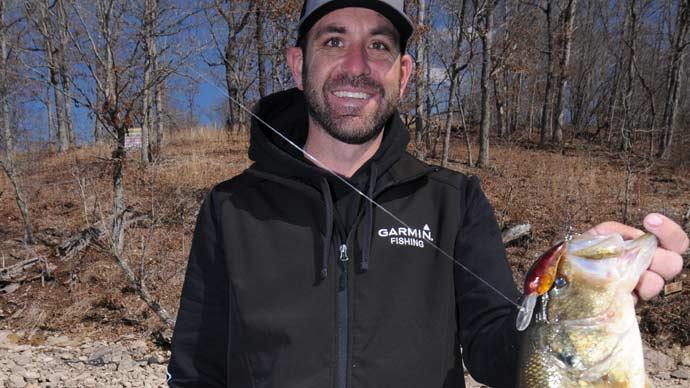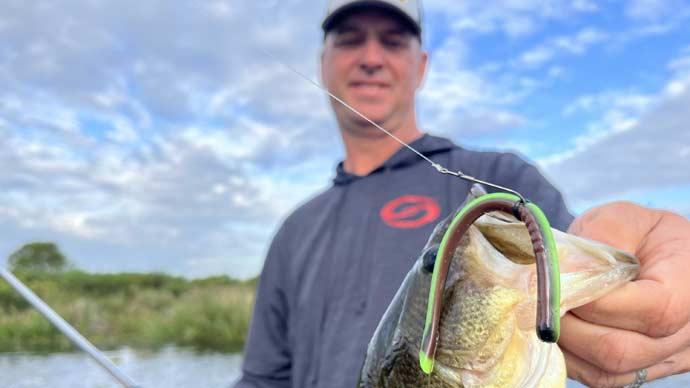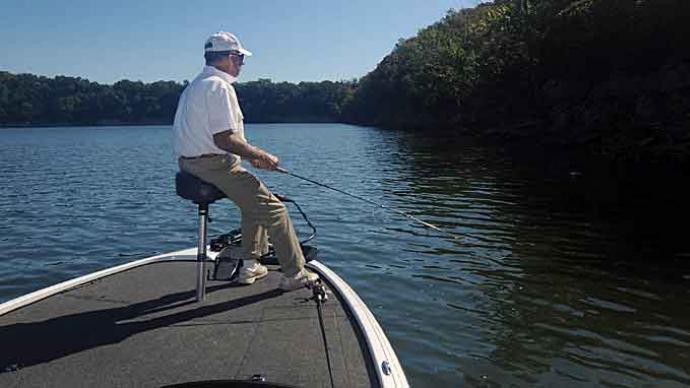
It's easy to make bass fishing complicated. Electronics, boats, rods, and reels are made in myriad sizes, shapes, and functions, each promising to catch more and bigger bass. There’s some truth in all those claims, but it takes experience, trial and error, and plenty of time on the water to realize it.
But focus on why you began bass fishing, and you’ll find a slew of straightforward reasons, such as enjoying the outdoors and spending time with family and friends. And right in that mix will be catching bass. A trip to your favorite fishing hole is always better when that happens.
Getting bass to bite starts with being in the right place at the right time. But it won't happen if you show them a lure that doesn't interest them. While every lure has its prime time, a handful consistently produce bass, even with little input from the angler. These are three of the best.
Versatility is a big reason why these baits are kings of catching. They're easy to fish in various covers, depths, and conditions. They can be presented on almost any combination of rod, reel, and line. And best yet, all three of the most popular bass species — largemouth, spotted, and smallmouth — readily eat them. So, regardless of whether you're a beginner or an expert, you’ll want to keep these rigged and ready.
Popper
These classic topwaters, led by Arbogast’s Hula Popper, are familiar to even beginning bass anglers. Their concave mouths chug and spit with every rod-tip twitch. A slim body and dual treble hooks — the rear typically adorned with feathers or fibers — complete the package. While they’re intended to imitate a small baitfish, you’ll find them painted with frog patterns, too. And best of all, they draw the explosive surface strikes that all bass anglers crave.
How to fish them
Your dad, grandfather, or fishing mentor probably counseled you to let your popper sit motionless after it lands, allowing the "rings" to disappear. Then, give it a twitch and repeat the wait. That move will still catch bass, especially those sulking around heavy cover in shallow water, where they need time to find your offering.
But contrary to traditional wisdom, speed generates more bites from a popper. That better imitates a disoriented baitfish scurrying along the surface. It also forces bass into a reaction strike — bite now or lose this meal forever. So, point the tip of your fast-action rod toward the water, moving its tip with a series of quick downward twitches, slowly winding in line between them.
You don't have to break stride on this retrieve; twitch your popper to the boat. It will work under most conditions. But when the surface slicks off, and the sun is high, some pauses will sweeten the deal. One every two or three twitches usually works. Experiment with different durations until you generate consistent strikes.
What makes a good popper?
Tackle shops are flooded with choices when it comes to poppers. Determining the one you should buy boils down to a few characteristics. Consider these:
- Body: Look for ones that have a long, thin, and narrow shape. That will ensure its profile resembles a baitfish. It'll dart and shimmy with each twitch.
- Mouth: The best ones are big and flat. They collect more water and push it farther forward, creating a significant disturbance, which attracts more bass.
- Hooks: High-quality ones with sticky points and round bends hold best. You can also swap out the OEMs; choose one size bigger to grab bass that simply swipe at your popper.
- Attraction: Dressing on the rear treble or rattles inside the body gives bass more reasons to bite your popper. Both are welcome additions, even in clear water.
If you think there are a ton of popper styles, wait until you check out the color selection. Luckily, you only need to stick to a few reliable ones. Natural or translucent colors are best when the water is clear. Darker patterns work best when the sky darkens or the water is stained. Here are three you should carry:
- Baitfish: Silver with a black or blue back are the most popular popper patterns. But translucent ones that sport hints of white, green, brown, or chartreuse are good, too.
- Bone: This pale monochromatic offering works in a variety of conditions. It’s often made better with an orange belly.
- Black: Keep this handy for special occasions such as a dark and stormy day or water that’s almost muddy. Its sharp silhouette is easy for bass to find.
Once you've picked the perfect popper, don't relegate it to shallow water. A speedy retrieve along a riprap bank will catch plenty of bass. But don't hesitate to throw it at schooling bass herding baitfish to the surface in open water over deep-water structure.
Medium-Diving Crankbait
Image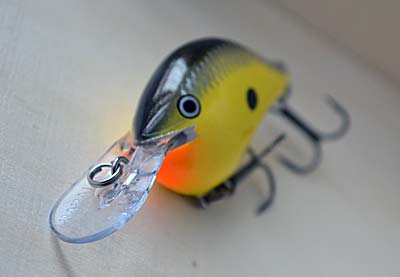
Medium-diving crankbaits can be fished in various depths and conditions — putting your lure in front of more bass in less time — and draw reaction strikes, which means even bass not interested in striking will bite. Photo by Pete M. Anderson When bass won’t come up to eat a lure, you must go down after them. And a few other lures do that, as well as a crankbait. While square-billed models catch plenty of shallow-water bass, and long-billed deep-divers rule offshore structure in the summertime, medium-divers are the real workhorse. And that’s the one more anglers use to catch more bass.
How to fish them
Medium-divers sport a bill almost as long as their 2- to 3-inch body. They dive upwards of 10 feet, though the sweet spot for most is between 6 and 8 feet. Popular models include Bandit 200, Rapala DT6 or DT8, Berkley Dredger 8.5, and Norman Deep Little N. They cover a wide depth range. They're equally at home bouncing through cover in 2 feet of stained water, such as touching down on the hard bottom outside of a bed of aquatic vegetation growing in 10 feet.
You'll catch bass by simply casting your crankbait and winding it back to the boat. But you'll get more bites and put more in the boat by angling your casts, so your crankbait spends the most time in productive water. For example, if you are fishing a long riprap bank, avoid casting perpendicular to it. Instead, move your boat close and cast parallel to it. Apply that approach to other situations. Cast along the edge of aquatic vegetation where it meets rock or some other hard bottom.
Crankbaits make a lot of noise, whether swishing hooks, shaking rattles, or grinding against the bottom. If that happens consistently, bass will often only follow them. You have to give them a reason to hit. And that is where an occasional pause in your retrieve comes into play.
Make your medium-diving crankbait better.
You don't have to do much to catch bass with a medium-diving crankbait: Take it out of the package, tie it to your line, and start casting. But a few tweaks will make it better. Try these:
- Light line: Tie onto 8- or 10-pound test monofilament or fluorocarbon line, and your crankbait will dive deeper and have more action than if you used stronger line, thanks to its small diameter.
- Slow-action rod: These flex from the tip to nearly the grip. They easily cast light lures and act like shock absorbers, keeping jumping and lunging bass hooked on trebles.
- Rounded bill: The front edge of your crankbait's bill should be rounded. That will help it roll around logs, rocks, and anything else its path crosses while you grind it along the bottom.
Don’t get lost in crankbait colors; there’s more than plenty of them. While you might find an off-the-wall pattern that holds your confidence because it produces on your favorite water, stick to these three patterns to catch bass wherever you fish.
- Baitfish: Choose shad if you are fishing on a Southern reservoir. If you’re fishing in the North, lean toward yellow perch.
- Crawfish: While the markings are the same, these can come in brown, green, orange, or chartreuse sides. Just make sure its belly is orange.
- Chartreuse: The one with the blue back is a longtime favorite, and it works well wherever bass swim. Pearl sides with a chartreuse back and runs a close second.
Stick Worm
Image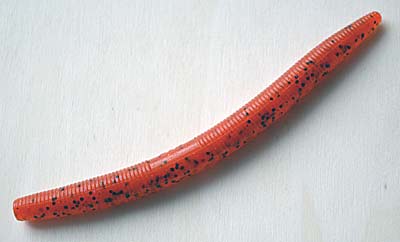
There isn’t a bass swimming that can resist a stick worm's subtle action and shape. Rig one wacky style, cast it next to the visible cover, and hold on. Photo by Pete M. Anderson While topwater lures may be the most nostalgic, soft-plastic lures — “plastic worms” — are most closely associated with bass fishing. And that’s for good reason. No other type of lure catches more and bigger bass year in and year out.
New shapes and sizes of soft-plastic lures are introduced every year. But the simple and straight stick worm has stood above all the rest for at least the past two decades for a simple reason — it catches bass everywhere. The poster child for the stick worm is Yamamoto's Senko, though other manufacturers have created versions, including YUM's Yumdinger, Zoom's Zlinky, and Berkley's The General. Whichever one you choose, it won’t be long before it gets bit by a bass.
How to fish them
Stick worms are about as easy as it gets to fish. Cast it out, let it sink, and set the hook when you feel a bite. The less you move it, the more bites you'll get. That's because they create their own undulating action. It's subtle but enough to get almost every bass to strike.
Unleashing a stick worm’s built-in action requires a vertical presentation. You want it to sink where you think a bass is holding. So, seek out spots offering a distinct structure, such as a creek channel bend or copious amounts of cover. Some of the best places to fish one include:
- Boat docks: Smooth sides mean stick worms can skip along the surface like a flat rock. That allows you to get into tight spots underneath docks, where big bass hide in the shade, and other anglers struggle to reach.
- Aquatic vegetation: These spots are prime for stick worms. Cast to points and pockets around the edges or directly into holes within emergent or submerged beds.
- Eddies: These spots of slack water are found behind objects breaking current. Bass will hold in them, darting into faster water to snag a meal being washed downstream.
How to choose the best stick worm
Keep a limited color selection of stick baits. A green pumpkin one will work nine times out of 10. The same principle can be applied to size. A 5-inch model is the most universal, but keep a bag or two of the 4-inch ones on hand when fishing gets tough.
You don't need to get crazy with rigging, either. These three styles will cover from heavy cover to open water and everything in between.
- Texas: Hiding your hook's point inside the lure is a great move when cover is heavy. Ensure you use a large hook — at least 4/0 — so there's enough gap for lure and bass. Weight or weightless — you choose.
- Wacky: This may be the best rigging option, with the hook impaled once through the stick worm's center. It leaves both ends free to "wave" as the bait sinks. Fish it weightless for best results.
- Shaky: Threaded onto a jig head, this will bring your stick worm to bass in deep water. The added weight also means you can fish it faster.


